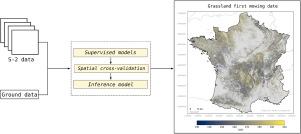当前位置:
X-MOL 学术
›
Remote Sens. Environ.
›
论文详情
Our official English website, www.x-mol.net, welcomes your
feedback! (Note: you will need to create a separate account there.)
Nationwide operational mapping of grassland first mowing dates combining machine learning and Sentinel-2 time series
Remote Sensing of Environment ( IF 11.1 ) Pub Date : 2024-10-30 , DOI: 10.1016/j.rse.2024.114476 Henry Rivas, Hélène Touchais, Vincent Thierion, Jerome Millet, Laurence Curtet, Mathieu Fauvel
Remote Sensing of Environment ( IF 11.1 ) Pub Date : 2024-10-30 , DOI: 10.1016/j.rse.2024.114476 Henry Rivas, Hélène Touchais, Vincent Thierion, Jerome Millet, Laurence Curtet, Mathieu Fauvel

|
Grassland dynamics are modulated by management intensity and impact overall ecosystem functioning. In mowed grasslands, the first mowing date is a key indicator of management intensification. The aim of this work was to assess several supervised regression models for mapping grassland first mowing date at national-level using Sentinel-2 time series. Three deep-learning architectures, two conventional machine learning models and two threshold-based methods (fixed and relative) were compared. Algorithms were trained/calibrated and tested from field observations, using a spatial cross-validation approach. Our findings showed that time aware deep-learning models – Lightweight Temporal Attention Encoder (LTAE) and 1D Convolutional Neural Network (1D-CNN) – yielded higher performances compared to Multilayer Perceptron, Random Forest and Ridge Regression models. Threshold-based methods under-performed compared to all other models. Best model (LTAE) mean absolute error was within six days with a coefficient of determination of 0.52. Additionally, errors were accentuated at extreme (late/early) mowing dates, which were underrepresented in the data set. Oversampling techniques did not improve predicting extreme mowing dates. Finally, the best prediction accuracy was obtained when the number of clear dates surrounding the mowing event was greater than 2. Our outputs evidenced time aware deep-learning models’ potential for large-scale grassland first mowing event monitoring. A national-level map was produced to support bird-life monitoring or public policies for biodiversity and agro-ecological transition in France.
中文翻译:

结合机器学习和 Sentinel-2 时间序列的草原首次割草日期的全国业务绘图
草原动态受管理强度的调节,并影响整体生态系统功能。在修剪过的草原上,第一次割草日期是管理集约化的关键指标。这项工作的目的是评估几个监督回归模型,用于使用 Sentinel-2 时间序列在国家层面绘制草原首次割草日期。比较了三种深度学习架构、两种传统机器学习模型和两种基于阈值的方法(固定和相对)。使用空间交叉验证方法,从现场观察中对算法进行训练/校准和测试。我们的研究结果表明,与多层感知器、随机森林和岭回归模型相比,时间感知深度学习模型——轻量级时间注意力编码器 (LTAE) 和一维卷积神经网络 (1D-CNN)——产生了更高的性能。与所有其他模型相比,基于阈值的方法表现不佳。最佳模型 (LTAE) 平均绝对误差在 6 天内,决定系数为 0.52。此外,在极端(晚/早)割草日期时,错误更加严重,这在数据集中的代表性不足。过采样技术并没有改善预测极端割草日期。最后,当割草事件周围的明确日期数大于 2 时,获得了最佳预测精度。我们的输出证明了时间感知深度学习模型在大规模草原首次割草事件监测方面的潜力。制作了一张国家级地图,以支持法国的鸟类生活监测或生物多样性和农业生态转型的公共政策。
更新日期:2024-10-30
中文翻译:

结合机器学习和 Sentinel-2 时间序列的草原首次割草日期的全国业务绘图
草原动态受管理强度的调节,并影响整体生态系统功能。在修剪过的草原上,第一次割草日期是管理集约化的关键指标。这项工作的目的是评估几个监督回归模型,用于使用 Sentinel-2 时间序列在国家层面绘制草原首次割草日期。比较了三种深度学习架构、两种传统机器学习模型和两种基于阈值的方法(固定和相对)。使用空间交叉验证方法,从现场观察中对算法进行训练/校准和测试。我们的研究结果表明,与多层感知器、随机森林和岭回归模型相比,时间感知深度学习模型——轻量级时间注意力编码器 (LTAE) 和一维卷积神经网络 (1D-CNN)——产生了更高的性能。与所有其他模型相比,基于阈值的方法表现不佳。最佳模型 (LTAE) 平均绝对误差在 6 天内,决定系数为 0.52。此外,在极端(晚/早)割草日期时,错误更加严重,这在数据集中的代表性不足。过采样技术并没有改善预测极端割草日期。最后,当割草事件周围的明确日期数大于 2 时,获得了最佳预测精度。我们的输出证明了时间感知深度学习模型在大规模草原首次割草事件监测方面的潜力。制作了一张国家级地图,以支持法国的鸟类生活监测或生物多样性和农业生态转型的公共政策。


















































 京公网安备 11010802027423号
京公网安备 11010802027423号